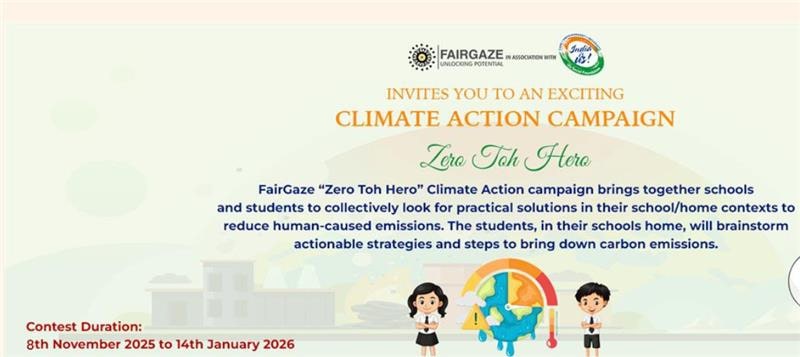
Possible Schemes from the Government to tackle Pollution in India
Education News | Dec-31-2022
The nation's government is making every effort to reduce air pollution. To reduce, control, and prevent air pollution throughout the nation, the Central Government has implemented several regulatory measures.
Action Plans for Improvement of Air Quality
1. 102 non-attainment cities, most of which are located in the Indo-Gangetic Plains, have been identified based on ambient air quality data for the period 2011 to 2015 and the WHO report 2014-2018. The National Clean Air Programme (NCAP) was launched by the Central Government under the Central Sector "Control of Pollution" Scheme as a long-term, time-bound, national-level strategy to address the issue of air pollution throughout the country in a comprehensive manner. The goals of the program are to achieve all 102 non-attainment cities that have received approval to implement city-specific Action Plans on the ground.
2. The Focal Government has told an Exhaustive Activity Plan (CAP) in 2018 distinguishing timetables and executing organizations for activities recognized for counteraction, control, and relief of air contamination in Delhi and NCR.
3. On January 12, 2017, the Graded Response Action Plan (GRAP) was announced to reduce, prevent, and control air pollution in Delhi and the NCR. For each of the four AQI categories—Moderate to Poor, Very Poor, Severe, and Severe + or Emergency—it identifies graded measures and implementing agencies.
Several initiatives have been implemented to raise public awareness. The following are the steps:
1. The SAMEER app has been released, offering public access to information about air quality and the ability to file complaints about activities that pollute the air.
2. A single location is used to collect and distribute information about air quality. It informs all stakeholders of the status of the air quality in real-time.
3. Twitter and Facebook accounts, as well as a media corner, have been established to facilitate public complaints and provide access to information on air quality.
4. The CPCB website is used to solicit innovative public ideas, suggestions, and proposals to bolster efforts to improve Delhi-NCR's air quality.
5. The Environment Education, Awareness, and Training Scheme is being implemented by the Ministry of Environment, Forest, and Climate Change to raise environmental awareness among all segments of society and encourage participation in environmental preservation. Under the Public Green Corps (NGC) program the Service, around one lakh schools have been recognized as Eco-clubs, wherein, almost thirty lakh understudies are effectively partaking in different climate security and protection exercises, including the issues connected with air contamination.
6. The ministry encourages citizen participation in environmental conservation by promoting cycling, conserving water and electricity, growing trees, maintaining vehicles properly, adhering to lane discipline, and reducing traffic on roads through carpooling, among other methods.
7. Since October 7, 2019, 46 teams of the Central Pollution Control Board have been deployed to collect feedback from the field regarding activities that pollute the air in Delhi and other major NCR towns.
Since 2016, the government has taken steps to reduce and control air pollution in Delhi and the New Delhi and Nagar Haveli (NCR). According to data from Continuous Ambient Air Quality Monitoring Stations (CAAQMS), the number of days classified as "Good," "Satisfactory," and "Moderate" has steadily increased to 159 in 2018, up from 152 in 2017 and 106 in 2016, while the number of days classified as "Poor," "Very Poor," and "Severe" has decreased to 206, down from 213 in 2017 and 246 in 2016. In Delhi, PM2.5 levels decreased by 7.3% in 2018 compared to 2017 and 14.8% in 2016. In Delhi, PM10 levels decreased by 8.6% in 2018 compared to 2017 and 16.5% in 2016.
There is a large improvement in the air quality of Delhi in 2019 (From Jan 2019 - 18th November 2019) progressively beginning around 2016. The number of days classified as "Good" to "Moderate" increased to 175 in 2019, up from 158 in 2018, while the number of days classified as "Poor" to "Severe" decreased to 147, down from 164 in 2018.
ANAND SCHOOL FOR EXCELLENCE
Related News
-
Relationship Between Poverty and Health
-
Indigo Cultivation: Challenges and Opportunities
-
Economic Significance of Indigo Plantation
-
Impact of Synthetic Indigo on Traditional Indigo Farming
-
Leadership Skills Developed by Student-Coached Teams
-
Inclusive Strategies Benefit Diverse Learners
-
Mindfulness Practices Implemented to Reduce Stress
-
Mental Health Programs for Student-Athletes Gain Support
-
The Importance of Financial Literacy for College Students
-
The Impact of Climate Change on Extreme Weather
Most popular news
- The Law Of Equivalent Exchange
- Essay On Issues And Challenges Of Rural Development In India
- Srinivasa Ramanujan And His Inventions
- The Youth Is The Hope Of Our Future!
- Poverty In India: Facts, Causes, Effects And Solutions
- Top 20 Outdoor Games In India
- Festivals Of India: Unity In Diversity
- Role Of Women In Society
- The Impact Of Peer Pressure On Students' Academic Performance
- Books As Companion
MUN Events



